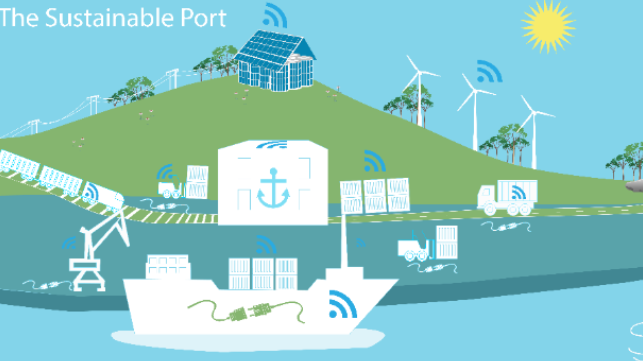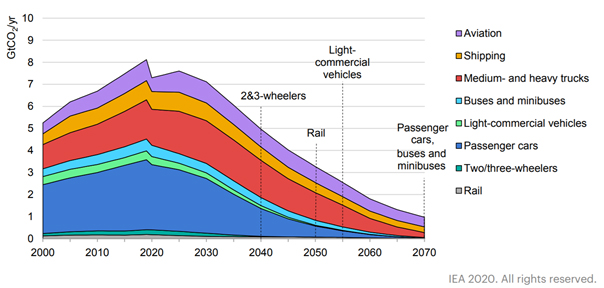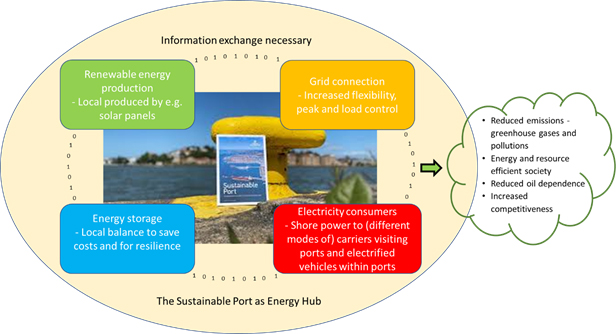Sustainable Ports as Energy Hubs

[By Mikael Lind, Stefan Pettersson, Jörgen Karlsson, Bart Steijaert, Patrik Hermansson, Sandra Haraldson, Monica Axell, Almir Zerem]
Society’s contribution to greenhouse gases is one of the biggest threats for the future of our planet and transport operations account for at least 20 percent of the world’s total greenhouse gas emissions. In many transport chains, several different means of transport are utilized, and numerous transport hubs are used for transhipment. To achieve fossil fuel free operations, transport hubs need to support those chains by providing, for example, green electrical power. There is now a strong call for the port of tomorrow to expand its capabilities beyond the port as a transhipment hub providing physical services, as an energy hub. In this short statement we elaborate on the opportunities provided by the collaboration between energy companies and ports empowered by digitalisation.
The transport industry needs to take responsibility for reducing greenhouse gas emissions
Emissions must decrease both to reduce global warming caused by greenhouse gases like carbon dioxide and to reduce the number of people dying or being affected directly by the effects of pollution. There is a need to shift from fossil-fuelled vehicles to vehicles running on fossil-free fuels, like hydrogen or biofuels, or electricity produced by renewable sources like solar, wind and hydropower. This is because transport accounts for around one-fifth of global carbon dioxide (CO2) emissions from energy sources. In the graph in Figure 1 below, the distribution of emission, including predictions to 2070, over different means of transport is shown.

Notes: Dotted lines indicate the year in which various transport modes have largely stopped consuming fossil fuels and hence no longer contribute to direct emissions of CO2 from fossil fuel combustion. Residual emissions in transport are compensated by negative emissions technologies, such as BioEnergy with Carbon Capture and Storage (BECCS) and Direct Air Capture (DAC), in the power and other energy transformation sectors.
Figure 1: Global CO2 emissions from transport in the IEA’s Sustainable Development Scenario to 2070 (page 154).
Ports are essential in the green conversion of transport
The UN International Maritime Organization predicts that maritime transport will increase by up to 250 percent by 2050. At the same time, the maritime industry, which today accounts for 2-3 percent of the world's total greenhouse gas emissions, needs to adjust to become more sustainable. Electrification is now a prominent trend in shipping, but the development needs to be accelerated. Increased electrification of the fleet will strongly contribute to more sustainable shipping. This obviously applies to ships, but also to all other forms of transport in and from the port, and the supporting infrastructure provided by ports. Furthermore, electrification of ports potentially also reduces noise which is important for the people working there and for the surrounding environment.
Reduction of greenhouse gas emission is a concern for all modes of transport. A (sea) port is a transhipment hub and thereby not only a window to the sea. Such ports are visited by multiple transport means and could provide the function of providing energy for the subsequent legs of transportation. Ports, and other transhipment hubs, can therefore play an important role in the green conversion of maritime and maritime-related transport.
Contemporary technical enablers
Digitalization is spreading in different parts of society. Due to the self-organising characteristics of shipping, and within the inter-modal transport system, collaboration is necessary between different actors to pursue transport with capital productivity and energy efficiency. Digitalization is enabling integration between the various actors in shipping, such as between carrier companies, ports and transport buyers. This and the development of Maritime informatics has united practitioners and researchers in improving the efficiency, sustainability, safety, and resilience of maritime supply chains empowered by digital collaboration, data sharing, and data analytics. Maritime informatics is an enabler for both the transport system as a whole and for various parts of maritime operations.
The interplay between digitalization and electrification in ports is an under-unexplored area. Having more electrified carriers means that re-charging facilities are required, putting demands on a re-charging infrastructure to be placed in the ports. Large electrified vessels require effects in MW size over extended and variable periods of time. The port itself thereby becomes an important node with significant power needs connected to the electricity grid. While many ships today are not propelled by an electric motor there is a global movement for them to connect to shore power when in port. Episodically visiting carriers, independent of transport mode, waiting to be served may want to re-charge batteries to secure energy for the next transport leg. The combined result of all these demands is that a port will be a large electricity consumer that is connected to the grid and must cater for a large and varied load requirement that can both help and upset the stability of the grid.
Towards a conception of the port as an energy hub
As an energy hub, a port’s demand for electricity, as being facilitated by the grid, will vary over time. Electrification of the transport sector increase the need for demand side management, cluster control and energy storage to offer peak load shaving and flexibility. Furthermore, it is large potential to save energy and increase the amount of local produced renewable energy. Digitalization will be the enabler and opens possibilities to innovative system solutions, intelligent control and new business models. As there is an exponential development of connected carriers, connected cargo and people, and more and more transactions are captured and tracked digitally, the granularity of situational awareness is continually improving. Not having been possible before, a port can now develop energy hub capabilities in which the energy requirements and distribution could be coordinated by digital means providing information about the timing and volumes of needed energy.
The following scenario is a realistic example. An electrified carrier calling a port needs to be charged with a certain amount of energy. It would be an advantage if this information is provided in advance to the electricity supplier to avoid the risk of power peaks in the network - that in turn drive costs and may otherwise affect service continuity. Vice versa, it can be advantageous to supply the carrier with power at an optimal time when the load is low in the network because then the energy is potentially cheaper, and the financial benefit will be higher for the shipping company. This simple example gives rise to a lot of follow-up questions related to technology, business models, agreements, planning, distribution and ownership of energy storage, needed information exchange, etc. Add the possibility for a port to produce its own electricity, such as by solar panels, and to store energy locally, for example using fixed banks of batteries or its own idle electrically powered vehicles, then it is quite obvious that this is an area that merits more investigation and development. Figure 2 is a schematic illustration of the components in a sustainable port seen as an energy hub.

Figure 2: Renewable energy production, energy storage, electricity consumers and grid connection, all exchanging relevant information, are essential components in a sustainable port seen as an energy hub, potentially leading to reduced emissions, efficiency, reduced oil dependency and increased competitiveness.
An emerging landscape of collaborative innovation
Having taken the first step towards electrified port transport vehicles, many port environments in Sweden, are now taking the next step in planning for the establishment of energy hub capabilities, to support visiting carriers of different modes with electricity. Crucial relationships are now being developed between grid companies, local energy companies, and the port.
Following the smart port concept beneficial cargo owners demand more and better information about the goods' status and delivery time in order to be able to optimize and streamline their own processes and transport to and from their operations. Tomorrow’s cargo owners also require that the various modes of transport are made as energy efficient as possible. There is also a strong drive towards establishing formal (legal) requirements to be able to deliver onshore power to all vessels calling at Swedish ports and it is expected that there will also be requirements put in place to deliver energy services to other means of transport. Cities are increasing pressure on their ports to run all the work machines on fossil-free fuels according to local and regional Climate and Energy Plans. Electrification and fossil free transports will accelerate the climate and energy transition and at the same time improve the air quality in the cities. To solve these challenges, a port needs to develop capabilities to provide electricity to operate vehicles and machines used within the port as well as obtaining electrical connections to all berths that handle ships.
As ports are not energy companies and electrification most often is not the core competence, there is a need to engage in collaboration with local energy companies. What we see is that there now is a strong development towards establishing collaborative innovation processes between ports and local energy companies. High on the agenda for the energy company is to secure capacity for delivering the electricity needed for a port’s operations and its visitors as well as the placement and ownership of energy storage. The information interface between the different subsystems needs to be defined and the business models must be worked out. Furthermore, since the energy companies provide electricity to not only ports, the planning must be seen in the light of municipal and regional development.
Concluding remark
The maritime sector alone accounts for 2-3 percent of the word’s total greenhouse gas emissions. It is why initiatives are being taken to make maritime transport as fossil-fuel free as possible. This is especially so because the volume of transport carried by sea is expected to rise by 250 percent by 2050. The initiatives are focused upon both the energy used for moving carriers by the use of different energy sources, and how to make movements as efficient as possible by measures such as green routing and green steaming.
However, and maybe even more important, ports in their capability of being a transhipment hub, have a great opportunity to support the green conversion by supplying electricity to visiting carriers of different modes of transport. The port as an energy hub will be an important competitive advantage in the future for what is starting to become required by the buyers of transport services.
For the latter, digital collaboration plays an important role in generating numerous data streams available for use in the different domains of application, such as just-in-time shipping, supply chain visibility, resource optimization, and the planning for the use of electrification in ports. A core ingredient in maritime informatics is to support the development towards the concerns raised by the transport sector in its effort of balancing capital productivity and energy efficiency. An unresolved quest is now whether the many ports in the world are ready to make the necessary upgrade to help save the planet for our future generations. In Sweden, some pioneering steps are now being taken in which ports are exploring the route of collaboration, between each other such as in the case of the Swedish initiative I Hamn gathering Swedish small and medium size ports, and with other industries, such as energy companies, to develop its hub capabilities. Is the rest of the world following the same patterns? It is time to prepare and form relevant energy hub port projects under the European Union Green Deal initiative.
The port as an energy hub is one of three legs of research into the sustainable port being pursued by RISE, together with the port as a transhipment hub and the port as information hub.
About the authors
Mikael Lind is Associate Professor and Senior Strategic Research Advisor at Research Institutes of Sweden (RISE) and has a part-time employment at Chalmers University of Technology, Sweden. He serves as an expert for World Economic Forum, Europe’s Digital Transport Logistic Forum (DTLF), and UN/CEFACT.
Stefan Pettersson has several academic degrees from Chalmers University of Technology and he is an adjunct Professor there since 2017. Stefan has worked in the automotive industry at Volvo Technology. Currently, he is the Director of Electromobility at RISE, where he is responsible for a large portfolio of electromobility projects.
Jörgen Karlsson is head of ABB Marine Sweden that is committed to supporting the shipping industry’s decarbonization agenda with electric, digital and connected technologies that allow cleaner and more efficient operations. His field of expertise is Electrification and Digitalization and has held different business development positions within ABB and latest in Power Generation.
Bart Steijaert is CEO at the port of Helsingborg and has been working internationally in the port and logistics business since 1996. Bart has logistics engineering degree from Universities in Vlissingen (NL) and Ghent (B).
Patrik Hermansson works as Director of Strategy and Innovation at the energy service company Öresundskraft owned by city of Helsingborg. He has over 25 years of experience from innovative energy solutions and have a key role in the development of a sustainable energy system required for Helsingborg to become climate neutral at latest 2035.
Sandra Haraldson is Senior Researcher at Research Institutes of Sweden (RISE) and has driven several initiatives on digital collaboration, multi-business innovation, and sustainable transport hubs, such as the concept of Collaborative Decision Making (e.g. PortCDM, StationCDM, YardCDM) enabling parties in transport ecosystems to become coordinated and synchronised by digital data sharing.
Monica Axell has a PhD in Energy Engineering and is Research and Business Developer at Research Institutes of Sweden (RISE). She has worked with R&D related to energy since 1990 on national and international level. She has driven national and international collaboration in the field of energy such as the Celsius Initiative and IEA Heat Pump Centre.
Almir Zerem is Senior Solution Architect at Research Institutes of Sweden (RISE) with 20 years of experience from telecom and transports, both from private and public sectors.
The opinions expressed herein are the author's and not necessarily those of The Maritime Executive.
